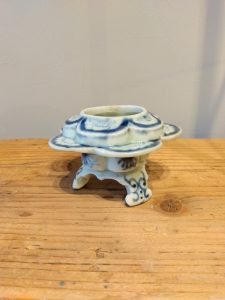今で言う人気の「フォント」ということでしょうか(愛知県名古屋市千種区姫池通 骨董買取 古美術風光舎)
2024.05.28
みなさまこんにちは。スタッフTでございます。
今日は雨の一日ですね。今年最初の台風も発生し、今日は警報級の雨の地域もあるようです。外出の際は足元にお気を付けくださいね。
ちなみに台風の名前は、国際機関「台風委員会」の加盟国などが提案した名称があらかじめ140個用意されていて、発生順につけられるのだそうです。
台風1号の名前「イーウィニャ」はミクロネシアが提案した名称で、嵐の神という意味のチューク諸島の伝統的な言葉からとられているそうですよ。

さて昨日は、先日こちらでつぶやきました藤原定家が『小倉百人一首』を完成させたことにちなんで「百人一首の日」でした。
『小倉百人一首』が完成したのは13世紀といわれていますが、800年近くたった今でも、日本の文化のひとつとして私たちの近くにあるのは素敵なことですね。
今も「かるた」として愛され続ける百人一首。
小倉百人一首は、公家である藤原定家が選んだ秀歌撰であると考えられており、定家の子、為家の舅である宇都宮頼綱(蓮生)の求めに応じて、定家が嵯峨小倉山荘において、天智天皇から順徳院まで百人の歌人の秀歌を各一首ずつ選び、百枚の色紙に揮毫したものとされています。
歌はほぼ時代順に配列され、すべて勅撰第一集から第十集の歌集から選ばれていて、うち94首までが八代集の歌となっています。『古今集』からの歌が最も多く24首。恋歌が最多で43首。作者は男性79人、女性21人です。
ちょうど今放送されている大河ドラマ「光る君へ」の登場人物の中には、紫式部、清少納言、藤原公任、赤染衛門など「百人一首」に選ばれた人が8人もいますね。「まひろ」というドラマでの呼び名がすっかり耳に馴染んでしまいましたが「紫式部」として登場するのはいつなのでしょうか。
話が逸れてしまいましたが、この『小倉百人一首』を編纂した藤原定家、「字は正確、書くのも早いが、決してうまい筆ではない」というのが当時の評価であったそうです。
「定家様」と呼ばれる特徴ある書体は、自分でもあまりうまい字とは思っていなかったよう。この書風は室町時代から江戸時代にかけて評判になります。当時の人々には親しみやすく、味のある筆に移ったようで、徳川家康なども使ったと言われているようですから、今で言う人気の「フォント」だったのでしょう。
「定家様」の魅力は一字一字が明確で堂々としていることだそうです。昔の書体というと、行書やかなの各字が切れずに連続して書かれているものが多い印象ですが、このかなの連綿も少ないそうです。藤原定家がこうした字を使いだしたのは、読みやすさ、写しやすさのためではないかと言われています。
とすれば、後に読む人のことを思っての心やさしい筆跡ということでしょうか。
ではでは、また。
Hello everyone. This is Staff T.
Today is a rainy day. The first typhoon of the year has hit the area, and it looks like there are some areas with warning-level rain today. Please watch your step when you go out.
The typhoons are named in the order of their occurrence, with 140 names proposed in advance by member countries of the Typhoon Committee, an international organization.
The name of typhoon No. 1, “Ewiniha,” was proposed by Micronesia and is taken from a traditional word in the Chuuk Islands meaning “god of storms.
Yesterday was “Hyakunin Isshu Day” in reference to the completion of “Ogura Hyakunin Isshu” by Fujiwara Teika, as I tweeted here the other day.
It is said that “Ogura Hyakunin Isshu” was completed in the 13th century, and it is wonderful that it is still around us as a part of Japanese culture nearly 800 years later.
The Hyakunin Isshu continues to be loved as “karuta” even today.
The Ogura Hyakunin Isshu is thought to be a collection of excellent poems selected by Fujiwara no Teika, a court noble, at the request of Utsunomiya no Yoritsuna (Renjo), a son of Teika and Tameie of Alexandria, who selected one poem each by 100 poets from Emperor Tenchi to Juntokuin and wrote them on 100 pieces of colored paper at Saga Ogura villa.
The poems are arranged in chronological order, and all were selected from the imperial anthologies 1 to 10, of which 94 are from the Yatsushiroshu. The largest number of poems, 24, are from the Kokinshu, and the largest number of love poems, 43, are from the Yatsushiroshu. The largest number of love poems, 43, are from the “Kokinshu. The number of authors is 79 males and 21 females.
Among the characters in the historical drama “To the Luminous Kimi,” which is being broadcast right now, there are eight people who were chosen for the Hyakunin Isshu, including Murasaki Shikibu, Sei Shonagon, Fujiwara no Kouto, and Akazome Emon. I have become familiar with the name “Mahiro” from the TV drama “Mahiro,” but when will she appear as “Murasaki Shikibu”?
I digress. Fujiwara Teika, who compiled the Ogura Hyakunin Isshu, was said to have been evaluated at the time that his handwriting was accurate and quick, but that he was not a good writer.
He did not think his distinctive style of calligraphy, called “Teika-sama,” was very good. This style of calligraphy became popular from the Muromachi period (1333-1573) to the Edo period (1603-1867). It seems to have moved to a familiar and tasteful brushstroke for the people of the time, and it is said that Tokugawa Ieyasu and others also used it, so it must have been a popular “font” as we know it today.
The charm of “Teika-sama” is that each character is clear and imposing. Many of the old typefaces are written in a series of unbroken kana or gyosho, but there are few examples of this kana renga. It is said that Fujiwara no Sadaie started using these characters for ease of reading and copying.
If this is the case, it may mean that he was thinking of those who would read his handwriting later on.
See you soon.
*******************
ご実家の整理やお片付けなどをされている方のご相談などが多くございます。
お片付けなどくれぐれもご無理のないようになさってくださいませ。
風光舎では古美術品や骨董品の他にも絵画や宝石、趣味のお品など様々なジャンルのものを買取しております。
お片付けをされていて、こういうものでもいいのかしらと迷われているものでも、どうぞお気軽にご相談下さいませ。
また風光舎は、出張買取も強化しております。ご近所はもちろん、愛知県内、岐阜県、三重県その他の県へも出張いたします。
まずは、お電話お待ちしております。
愛知県名古屋市千種区姫池通
骨董 買取【古美術 風光舎 名古屋店】
TEL052(734)8444
10:00-18:00 OPEN

